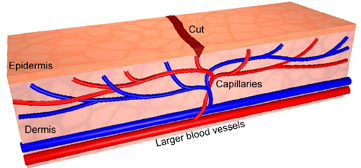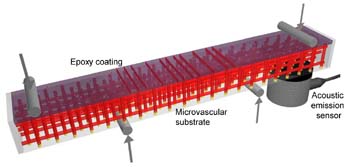μVac: Background, interpretation, and significance
This manuscript introduces a new generation of bioinspired materials that are able to repeatedly and autonomically heal crack damage through the incorporation of embedded microvascular networks. Delivery of healing agents to a damaged region via this microvascular network overcomes a significant limitation of previously reported, microencapsulated-based self-healing materials [White et al, 409, Nature, 794-797, 2001] i.e., the finite supply of healing agent contained within the capsules. The microvascular delivery mechanism provides a renewable source for the healing agents, which therefore enables repeated healing of fracture events and significantly extends the life of these materials.

This new healing concept for repeated healing of damage is modeled after vascular networks in nature. To demonstrate the use of microvascular networks for autonomic healing of structural damage, we explore a microvascular coating/substrate architecture that mimics human skin. Skin, which serves as a protective barrier, is made up of many layers of tissue and vessels that work together to repair damage [P. Martin, 276, Science, 7581, 1997]. In the schematic above, a cut in the epidermal layer triggers healing when blood in the capillaries deliver the necessary materials for wound repair. Due to the vascular nature of the supply system, minor damage to the same area can be healed repeatedly.

A coating/substrate geometry is used to test the delivery system without damaging the microvascular network. Specimens consist of a brittle polymer coating applied to a more ductile polymer substrate. The beam specimen contains a single microvascular network in the substrate for delivery of a fluid healing agent, and catalyst particles were incorporated in the coating directly. Restricting the cracks to the coating allows for the study of the healing capabilities without the complication of cracking the microchannels. The coated beams are loaded in four-point bending, and the brittle coatings develop cracks when a critical strain is exceeded. After the damage is healed, specimens are loaded again in four-point bending to examine the healing capabilities. Coatings on beam specimens achieve up to seven healing cycles for a single crack in the coating.
While the repeated self-healing of a microvascular system is a tremendous step over the microcapsule healing system, there are still areas for improvement. The repeated healing of a crack in a coating using a microvascular network is not limitless --- it is restricted by the finite supply of catalyst in the coating. While the fluid delivered through the network continues to fill the crack, access to the reactive catalyst in the crack plane decreases with each healing event. We are currently working on healing coatings with two or more microvascular networks in the substrate to supply a two-part healing chemistry, such as an epoxy resin and curing agent. Preliminary tests of this dual network system show that the number of possible healing events increases over the system with catalyst embedded in the coating. In addition to healing, biological systems utilize pervasive vascular networks to accomplish an extraordinary range of functions such as thermal regulation, growth, and chemical sensing. Hence, polymer composites with embedded microvascular networks provide a rich platform for creating truly autonomic materials systems. This nascent approach opens up new avenues to achieve materials with additional functionalities, such as self-diagnosis and self-cooling through delivery and circulation of active species. From biomaterials that promote tissue growth to fully regenerative materials, the applications are far reaching.
Reference

Kathleen S. Toohey, Scott R. White, Jennifer A. Lewis, Jeffrey S. Moore and Nancy R. Sottos, ''Self-Healing Materials with Microvascular Networks'', Nature Materials.
Published on line June 10, 2007, DOI: 10.1038/nmat1934.
Lead Author, Kathleen S. Toohey received her PhD in Theoretical and Applied Mechanics from the University of Illinois at Urbana-Champaign in May, 2007. She is currently working as a post-doctoral researcher in the Microvascular Autonomic Composites Group at the Beckman Institute.



